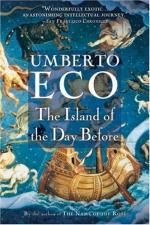|
This section contains 319 words (approx. 2 pages at 300 words per page) |

|
A complete study of the techniques Eco uses in The Island of the Day Before would have to be as long as the novel itself. Even a quick survey of a few of the narratorial ploys, however, suggests the remarkable qualities of Eco's third novel.
Like The Name of The Rose (1980), The Island of the Day Before is presented as if it Were based on a recently-discovered manuscript. The modern narrator takes on much more responsibility this time, since the papers Roberto left on board the Daphne constitute a narrative full of gaps. Indeed, they were never conceived as a connected story, unlike Adso's confessions. With much show of diffidence, the modern narrator conjecturally fills in the gaps and pieces together the tale. By this method, Eco succeeds in evoking Roberto's seventeenth-century sensibility, while the modern narrator intervenes to supply background and clarification.
This dual narrative is especially...
|
This section contains 319 words (approx. 2 pages at 300 words per page) |

|




